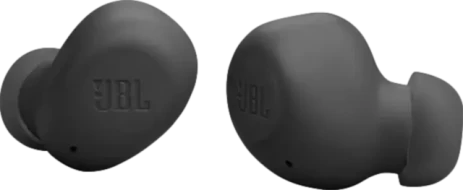IP ratings is the rating of protection offered by an enclosure, against dust and water. In the format of IPXX, 'X' represents a number The first value of the IP rating represents protection against solids say dust, while the second refers to protection against liquids (water).
Having a value of IP54, the JBL Wave Buds's rating for solids indicates that ingress of dust is not totally prevented but dust does not enter in harmful quantities to interfere with the correct operation or impair safety, and the second value of 4 means that they can withstand low pressure spray similar to that of a shower head when tilted at 180° for 10 minutes. JBL Wave Buds have a weight of 9g . We consider a lower weight better for the reason that lighter devices are more comfortable to carry.
True wireless devices have no wires linking any part of the device together, JBL Wave Buds are true wireless for this case since they don't have cables. This is a major difference as some wireless earbuds have cables linking the pair of earbuds .
JBL Wave Buds are resistant to sweat
JBL Wave Buds have stereo speakers, what this means is that JBL Wave Buds's speakers deliver sound from independent channels on both left and right sides, this creates a richer sound and a better listening experience. ANC makes use of more advanced technology to actively cancel noise.
ANC works when, it studies the sound pattern outside and inside the earbud and generates a mirror signal to counter it. Simply put, it's like taking +1 (sound from your surrounding) then adding -1 (inverted noise) giving zero hence "diluting" the noise.
The JBL Wave Buds have Active Noise Cancellation allowing you to listen at lower levels of volume, good for your ears as you don't need to crank up the earbuds volume to overcome background noise.
The JBL Wave Buds sit tightly in place, this creates a sound seal that reduces your environment noise and also prevents the device sound from leaking out at the same. JBL Wave Buds have a unit size of 8mm in diameter, bigger drivers are more powerful, therefor producing better bass. The driver unit is basically a mini speaker that produces sound in the device, the unit size determines the loudness of the earbuds.
JBL Wave Buds's lowest frequency is at 20Hz, low-frequency response measures if and how well an audio device produces low frequencies that can be heard, and if it alters the signal on its way through. JBL Wave Buds's highest frequency is at 20,000Hz, high-frequency response indicates how well an audio device makes high recognizable frequencies and if it makes any changes to the signal on its way through. SPL, is the pressure level of sound, in decibels, dB, JBL Wave Buds's measurement is 100dB/mW.
Devices with a higher sound pressure level are generally louder when supplied with any given audio source. The JBL Wave Buds's battery life is 8 hours, these last longer than 5 hours of listening which is considered average for a single charge. A device's battery life is given by the manufacturer, and with longer battery life, you get to use it for longer and requires fewer chargings.
This is given by the manufacturer, and the JBL Wave Buds's case has a full charge of 24 hours. A charging case with more battery hours allows you to recharge your earbuds on the go many times before having to recharge the case itself. It requires 2 hours to fully charge the JBL Wave Buds's battery.
It is recommended to charge fully the battery before using the earbuds for the first time. The JBL Wave Buds have a battery level indicator, an indicator notifies you when the earbuds has a low battery. Its lights indicate the charging status of your earbuds and case.
JBL Wave Buds support USB TYPE-C, a standard connector for transmitting both data and power through a single cable. JBL Wave Buds have Bluetooth version of 5.2, Bluetooth is a wireless technology standard that enables data movement between devices placed in range, using short-wavelength, ultra-high frequency radio waves. JBL Wave Buds have a 10meters distance connecting via Bluetooth.
JBL Wave Buds support AAC, a codec that is used for Bluetooth audio. It supports 24-bit audio at 250kbps. Since it uses psychoacoustic modeling, it provides better results than other codecs at the same bit rate.
Since its the highest quality codec that any Bluetooth-supporting Apple product supports, the JBL Wave Buds will work well with your iPhone. If you intend on using these with Android you need to pay even closer attention to codec support for if they only have AAC they won't provide the best audio quality possible, ensure that they also support aptX HD, LDAC, or LHDC as well. The JBL Wave Buds support APTX Adaptive, an audio codec for Bluetooth devices that are developed by Qualcomm.
It has a variable bit rate (between 279kbps and 420kbps).
The JBL Wave Buds have 2 microphones. The JBL Wave Buds use a noise-canceling microphone, these microphones are designed to filter out background sounds from the desired sound. The JBL Wave Buds microphone sensitivity is measured at -38dBV/Pa.
The amount of the analog or digital output signal from the microphone with its input stimulus is a measure of its sensitivity. It's the 'loudness' of the voice that the earbud microphone can recognize. JBL Wave Buds support ambient sound mode, which uses microphones to pass through ambient sound to still be heard even while wearing the earbuds
The JBL Wave Buds have in/on-ear detection, the sensors in the device can detect when removed from your ears .
When lost in a room, or can't be found in your bag, JBL Wave Buds have a find earbuds feature.
The JBL Wave Buds support fast charging. Most often, technologies like MediaTek’s Pump Express, are used to reduce the amount of time it takes to fully charge the earbuds. JBL Wave Buds support multipoint of 2 connections, the multipoint feature allows you to link to more than one Bluetooth device and switch between them.
For example, you can switch calls from one device to another without manually disconnect and reconnect. JBL Wave Buds have a mute function, they support the option to mute/unmute a conversation directly from the device. The JBL Wave Buds, so you can easily access the volume control, pause, play, mute, etc whichever features are supported on the earbuds.
The JBL Wave Buds support voice prompts. With voice prompts, you receive information through audio messages, say if there is an issue with the connection. JBL Wave Buds come with their own special pouch.
Carrying earphones openly, or placing them inside your pockets without a cover may easily damage them.











